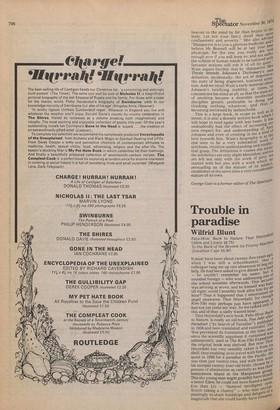Trouble in paradise
Wilfrid Blunt
Fatu-Hiva: Back to Nature Thor He (Allen and Unwin £4.75) m clean To the Bach of the Beyond Sir Fitzroy —a (Jonathan Cape £4.50)
It must have been about twenty-five years se It must have been about twenty-five years se onlY
had not yet come my way. So we talked a. when I was still a schoolmaster, that colleague rang me up one afternoon to beg IttY., help. He had been asked to give dinner to a rna,", — he couldn't remember his name, but sounded foreign — who was addressing one the school societies afterwards. This lector:, was arriving at seven, and he himself was bus; till eight; could I possibly look after him for hour? hour? Thus it happened that I entertaineu angel unawares: Thor Heyerdahl; for thoLigl Kon-Tiki may perhaps just have appeareCI, this and of that: a sadly wasted hour. Thor Heyerdahl's new book, Fatu-Hiva: Back.. to Nature, is really an old book, Paa Jakt eftei' Paradiset ("In Search of Paradise"), Publishin 1938 and here translated and extended. Titct War prevented its translation at the time, aric since the scientific argument it contained Wa'7 subsequently used in The Kon-Tiki Expedittonr the original book was shelved. But now. Heyerdahl has very sensibly taken it from shelf, thus enabling us to travel with him on 1,.11e quest in 1936 for a paradise in the Pacific. was then just twenty-two, and with him we"a his intrepid twenty-year-old bride, chosen tir process of elimination as carefully as was t"„; honeymoon island in the Marquesas grth',1; This shy young man might possibly have strtir,,r a better Eden; he could not have found a het's. Eve than Liv — "damned intelligent eY..fle Worth taking a chance" — who was unc°F-aplainingly to share hardships and dangers 0 Magnitude that she could hardly have foresee" Fr°rn Tahiti a copra-trading schooner carried
th
I ,s,e Young Norwegians to Fatu-Hiva, a remote . land, some ten miles long and four or five inhabited by a couple of hundred natives sTI`tled in two small villages on its western Tan ores. Thor and Liv — called Terai Mateata e and Terai Mateata Vahine (Mr and Mrs Sky) by the natives, who found their "rwegian names impossible to pronounce — headed for the wild interior of the island aan..,.(1 beuringgan to lead the simple life that looks so ll row in photographs which show tomors breakfast growing at your door, but not tvuose mosquitoes which will make the intertrerling night almost unbearable. Finally, ca] boils that might have cost them their ,egs if left' unattended, drove them back for a n ,arna e to 'civilisation' at Hivaoa, where Gauguin :7Idied only a generation before. „Like almost every book from the Bible Fatu-Hiva would have benefited by tr°1-1s pruning. But it is enormously readagrd idsh k_, and one becomes so involved in the ps endured that it is quite a surprise to
u:Tuuerring
sunr„, on closing its pages, that one is not from elephantiasis of the legs. solying the travelogue, however, is eolnething more important; for it was a „ nsideration of (amongst other things) the rInnitive sculptures he found on Fatu-Hiva ,,uat was to lead Thor Heyerdahl to make his '411ous Kon-Tiki expedition a decade later. _anowture? successful was this journey back to We hated leaving," he wrote. "We Liatedgoing back to civilisation. But it was So going we could not resist. We had to do it. a were sure then;and I still am, that the only Place where it is possible to find nature as it alw aYs was is within man himself." And he s'h',°ses his new book with the same words he used to close its forerunner: " `Liv,' I said, une can't buy a ticket to Paradise'." .15,Sir Fitzroy Maclean's To the Back of the ti-7343rld carries us through time as well as Ler,,°:ugh space: from Alexander the Great to h,, " and beyond; from Turkmenistan to the h.,"'°In ngolian People's Republic. Its author estly states that it is "neither a serious ',":nrk of scholarship nor even a serious travel i0k," and for this the general reader, at whom 6 is clearly directed, will be nothing but grateful. toSir Fitzroy achieves exactly what he set out read do: to provide an accurate yet eminently are able account of cities whose very names ,Tfe music _ Samarkand, Bokhara, Khiva — and h those warriors, adventurers, merchants iirlie,sts and miscellaneous riff-raff who played ,,„e'r various roles in the vast theatre of the s"astes of Central Asia. He knows Russia well, er'ep, 411-s Russian, and was lucky — and couraV.irtius — enough to have made his way in the es to several of the then forbidden cities of 6ssian Central Asia. Some of what he tells us is now readily available elsewhere, some of himself has already told us in earlier unc"; but there is also much that will be Larniliar to most readers.
weljute Most exciting chapter — though it may that turn 'rn the stomachs of the squeamish — is e in which he brilliantly describes the ro!cesses of that unspeakable monster Sukhe tror. It is here, however, that one most regrets ofe°Mission of a bibliography, or at all events ..wsorne mention of the sources he has used; "we flue
'
at —nigly non-committal. Further, the map a'e beginning of the book is not really it 'clnate for following the villain's movements; rZ.as not until I consulted the index that I th:4sed that Ulan Bator and Urga were one and pi':‘boOt a hundred and twenty-five of Sir hu4°Y's own photographs (the "nearly two mndred" of the blurb is somewhat exaggeratT add enormously to the value of this
ther delightful book.
No Blunt has most recently written a graPhy of Felix Mendelssohn.











































 Previous page
Previous page